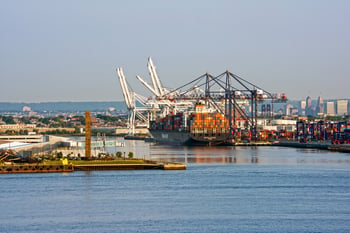Following years of record profits in the aftermath of the global pandemic, the container shipping industry has found itself in a precarious state.
A flood of new vessel orders – combined with plummeting cargo volumes – have extended a drop-off in global shipping rates, which on average have plunged more than 80% since their peak in late 2021.
Transatlantic container shipping rates, while trending downward, remain in a state of flux – and can vary widely depending on market conditions, fuel prices, global economic trends and more. It’s important for shippers to understand these factors to secure cost-effective transportation both today and in the long term.
Understanding Transatlantic Container Shipping Costs
Shipping rates for transatlantic containers have fluctuated wildly over the past few years. In 2020, the initial spread of COVID-19 stunted demand for shipping services – resulting in lower shipping rates for many routes, including those across the Atlantic.
 But starting in late 2020 and continuing into 2021, transatlantic container shipping rates began to increase rapidly due a surge in demand for goods from consumers who were spending more time at home, disruptions caused by labor shortages, and a global shortage of shipping containers and other equipment.
But starting in late 2020 and continuing into 2021, transatlantic container shipping rates began to increase rapidly due a surge in demand for goods from consumers who were spending more time at home, disruptions caused by labor shortages, and a global shortage of shipping containers and other equipment.
A few key factors continue to affect these rates:
- Carrier capacity: During periods of high demand, carriers may implement surcharges or increase rates to reflect the limited capacity.
- Fuel prices: Fuel prices can have a significant impact on container rates, as carriers often pass on the cost of fuel to shippers.
- Equipment availability: Shortages or imbalances in container supply can lead to higher rates or longer lead times, as carriers may need to reposition equipment or use alternative equipment types.
- Trade policies: Tariffs and changing trade policies can impact demand for shipping, as well as the cost of goods being shipped, which can in turn impact rates.
Where Are Transatlantic Container Shipping Rates Headed?
It's difficult to predict with certainty where global shipping rates are headed in the long term, but there are some indications that cost pressures are easing up for transatlantic voyages.
Containerships on order will add a whopping 7.48 million 20-foot equivalent units (TEUs) in the next two years – an overall capacity increase of nearly 30%. The bulging orderbook is a reflection of optimism by ocean carriers that scrambled to meet soaring demand for space during the height of the pandemic.
Now, as they cope with slackening demand for ship space, carriers could be setting the stage for a further plunge in rates. (Transatlantic container shipping rates are roughly 37% lower than a year ago, but remain more than double the cost in 2019.) Overall, the balance of power is shifting back to shippers.
It's worth noting that shipping rates can be highly volatile and subject to sudden shifts in response to changing market conditions and supply chain disruptions. Ultimately, vigilance on these trends is key.
How to Save on Container Shipping for Transatlantic Lanes
No matter which direction rates are trending, cost-effective container transport requires a strategic, proactive approach. Many shippers still face significantly higher costs for transatlantic services than they did in previous years, prompting some to explore alternative shipping methods or to adjust their supply chain strategies to mitigate the impact.
Here are a few ways to keep costs under control:
- Optimize container usage: You can work to optimize use of containers by maximizing capacity and minimizing empty space. By ignoring steamship line advice and maximizing the payload of each container you ship, it’s possible to reduce the number of containers and realize a 20% net savings – even with the added cost of using a heavy haul trucker for final delivery of the overweight container.
- Consolidate shipments: By consolidating with other shippers, small to midsize businesses with lesser volume can share the cost of container space and reduce the overall cost of shipping. This can be done through freight forwarders, consolidators or other logistics providers.
- Use alternative ports: Seeking alternative ports of departure or arrival can help bypass congestion and reduce costs. This can involve using smaller ports or ports that are less congested or have better infrastructure. For instance, containers destined for certain US locations might ship faster and cheaper via the Port of Montreal than a U.S. east coast port. See our article on Europe-to-Canada shipping.
- Find the right forwarder for your transatlantic lane: Forwarders that move a lot of volume on a lane have negotiating power with steamship lines and can offer more favorable transatlantic container shipping rates. For instance, I.C.E. Transport moves significant freight volumes between the U.S. and Eastern Europe, particularly Poland, and can offer both personalized service and attractive rates.
By exploring these options and working with logistics providers and carriers, shippers can optimize their supply chain and reduce transatlantic container shipping costs without sacrificing quality or service.
Experienced providers, like I.C.E. Transport, will understand the latest market conditions for transatlantic container shipments and help shippers avoid unnecessary costs.
If you want to make sure you’re getting the best combination of rates and service for your transatlantic lanes, feel free to contact the shipping experts at I.C.E. Transport for answers.




